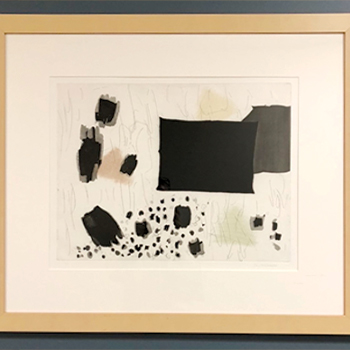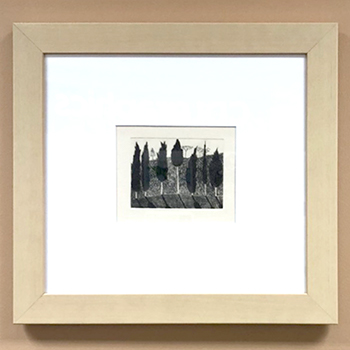
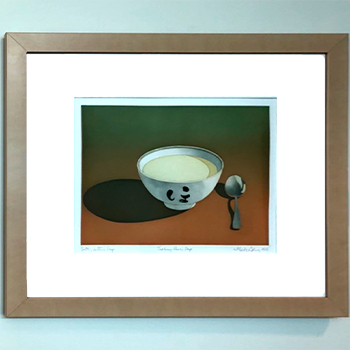
Beth’s Soup
Research Park
Beth’s Soup
Mark Adams
Etching
1982
Mark Adams, now remembered for his luminous watercolors, began his career as a designer of tapestries, as well as stained glass pieces for liturgical buildings in America. He was also skilled in a variety of art forms, including mosaics, printmaking, drawing, and oil painting. In 1975, Adams grew frustrated with his craft and his lack of complete control over the creative process, and devoted himself to painting in the hopes of creating small, intimate works. Adams realized that with watercolor, he could best apply his knowledge and techniques of working in flat planes of luminous and translucent color. His favorite subjects were quotidian or nostalgic objects or scenes borrowed directly from his own life and memories.
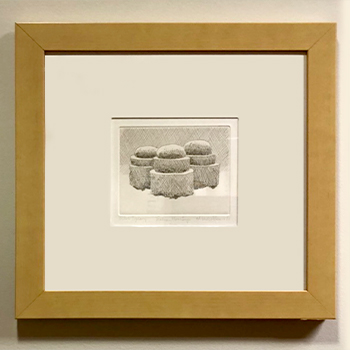
Filoli Topiary
Research Park
Filoli Topiary
Mark Adams
Etching
1983
Mark Adams, now remembered for his luminous watercolors, began his career as a designer of tapestries, as well as stained glass pieces for liturgical buildings in America. He was also skilled in a variety of art forms, including mosaics, printmaking, drawing, and oil painting. In 1975, Adams grew frustrated with his craft and his lack of complete control over the creative process, and devoted himself to painting in the hopes of creating small, intimate works. Adams realized that with watercolor, he could best apply his knowledge and techniques of working in flat planes of luminous and translucent color. His favorite subjects were quotidian or nostalgic objects or scenes borrowed directly from his own life and memories.
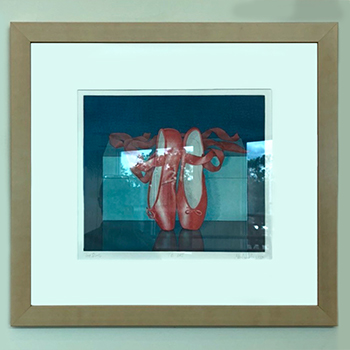
Toe Shoes
Research Park
Toe Shoes
Mark Adams
Etching
1993
Mark Adams, now remembered for his luminous watercolors, began his career as a designer of tapestries, as well as stained glass pieces for liturgical buildings in America. He was also skilled in a variety of art forms, including mosaics, printmaking, drawing, and oil painting. In 1975, Adams grew frustrated with his craft and his lack of complete control over the creative process, and devoted himself to painting in the hopes of creating small, intimate works. Adams realized that with watercolor, he could best apply his knowledge and techniques of working in flat planes of luminous and translucent color. His favorite subjects were quotidian or nostalgic objects or scenes borrowed directly from his own life and memories.
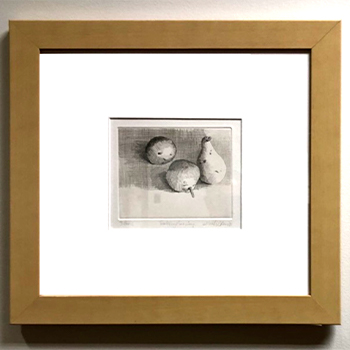
3 Pears
Research Park
3 Pears
Mark Adams
Etching
1983
Mark Adams, now remembered for his luminous watercolors, began his career as a designer of tapestries, as well as stained glass pieces for liturgical buildings in America. He was also skilled in a variety of art forms, including mosaics, printmaking, drawing, and oil painting. In 1975, Adams grew frustrated with his craft and his lack of complete control over the creative process, and devoted himself to painting in the hopes of creating small, intimate works. Adams realized that with watercolor, he could best apply his knowledge and techniques of working in flat planes of luminous and translucent color. His favorite subjects were quotidian or nostalgic objects or scenes borrowed directly from his own life and memories.
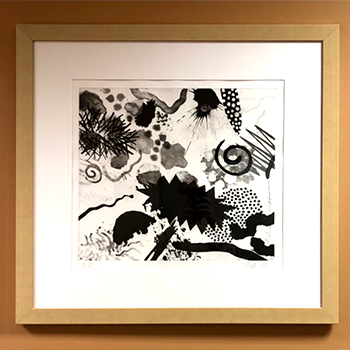
Gooeyduck
Research Park
Gooeyduck
Peter Alexander
Etching
1982
Peter Alexander is a contemporary American sculptor who was a part of the Light and Space movement along with Robert Irwin and Larry Bellduring the 1960s. His best known works are sculptures constructed from translucent plastic and resin, which respond to the light of the spaces in which they are shown. “I’m a romantic, and I believe in it. I believe in the value of things,” the artist has said. “I believe that objects can be made that can have an extraordinary effect on me and others.” Born on February 27, 1939 in Los Angeles, CA, he studied architecture in England before receiving both his BFA and MFA from the University of California, Los Angeles. Alexander started as an architect, before developing a reputation in the 1960s for creating his sculptures. More recently, he has shown himself to be a prolific painter, with many of his paintings depicting the landscape and night skyline of Los Angeles. Alexander currently lives and works in Santa Monica, CA. The artist’s works are held in the collections of the J. Paul Getty Museum in Los Angeles, The Museum of Modern Art in New York, and the Walker Art Center in Minneapolis.
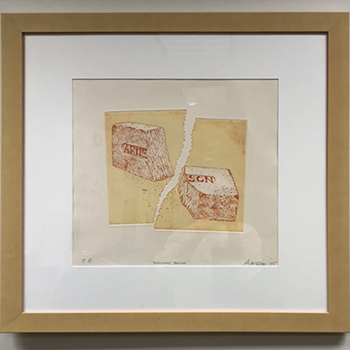
Broken Brick
Research Park
Broken Brick
Robert Arneson
Etching
1977
He was born on September 4, 1930 in Benicia, CA and studied at California College of the Arts after working as a cartoonist for a local newspaper. Robert Arneson was an American sculptor and ceramicist who is considered as the father of Funk Art, the anti-establishment movement that incorporated a mélange of found objects, autobiographical subjects, and humor. He died on November 2, 1992 in Benicia, CA from liver cancer, and his works can be found in major institutions around the world including including the Chicago Art Institute, the Hirshhorn Museum and Sculpture Garden in Washington, D.C., the Metropolitan Museum of Art in New York, and the Smithsonian American Art Museum in Washington, D.C.
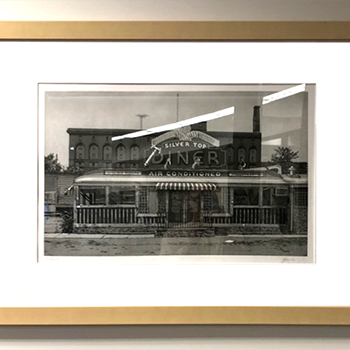
Silver Top
Research Park
Silver Top
John Baeder
Etching
1987
John Baeder is known for paintings and prints of roadside diners. In the 1950’s he was highly influenced from road trips to and from Atlanta and Auburn University where he was a fine arts student. His work was part of the post-war realist movement and is linked to 18th century Romanticism, specifically the genre of “grand tour” travel paintings.

Barbershop
Research Park
Barbershop
Timothy Berry
Etching
1974
Timothy Berry has been a practicing artist for over 30 years. His paintings, drawings, and prints have been exhibited extensively in museums and galleries throughout the United States and Europe, including 21 solo and 75 group exhibitions. He is also a dedicated art educator, having taught and lectured at university level for 33 years. He is presently on the faculty of the San Francisco Art Institute.
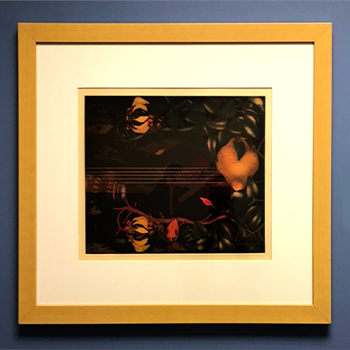
Culture Mine
Research Park
Culture Mine
Timothy Berry
Etching
1991
Timothy Berry has been a practicing artist for over 30 years. His paintings, drawings, and prints have been exhibited extensively in museums and galleries throughout the United States and Europe, including 21 solo and 75 group exhibitions. He is also a dedicated art educator, having taught and lectured at university level for 33 years. He is presently on the faculty of the San Francisco Art Institute.
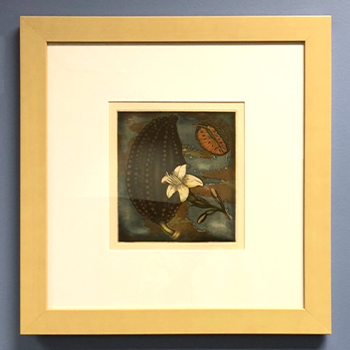
Details
Research Park
Details
Timothy Berry
Etching
1991
Timothy Berry has been a practicing artist for over 30 years. His paintings, drawings, and prints have been exhibited extensively in museums and galleries throughout the United States and Europe, including 21 solo and 75 group exhibitions. He is also a dedicated art educator, having taught and lectured at university level for 33 years. He is presently on the faculty of the San Francisco Art Institute.
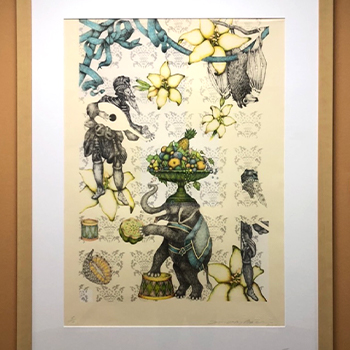
Restoration Repose
Research Park
Restoration Repose
Timothy Berry
Etching
1991
Timothy Berry has been a practicing artist for over 30 years. His paintings, drawings, and prints have been exhibited extensively in museums and galleries throughout the United States and Europe, including 21 solo and 75 group exhibitions. He is also a dedicated art educator, having taught and lectured at university level for 33 years. He is presently on the faculty of the San Francisco Art Institute.
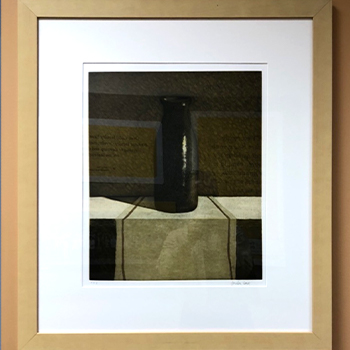
Milk Bottle
Research Park
Milk Bottle
Gordon Cook
Etching
1982
Gordon Cook, printmaker, painter, sculptor, and educator, was born in Chicago on October 3, 1927. Between 1945 and 1950, he was enrolled in studies at Illinois Wesleyan University where he earned his BFA. Cook studied intaglio printmaking with Vera Berdich in 1949 and attended S.W. Hayter’s lectures at the School of the Art Institute of Chicago. He relocated to Iowa City in 1950 for graduate studies in printmaking with Mauricio Lasansky.
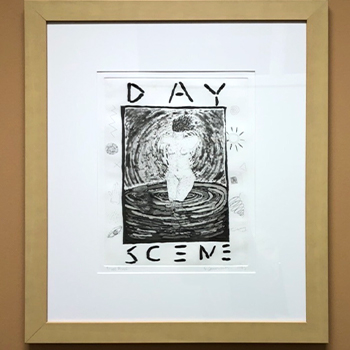
Day Scene
Research Park
Day Scene
Squeak Cornwath
Etching
1983
Squeak Carnwath draws upon the philosophical and mundane experiences of daily life in her paintings and prints, which can be identified by lush fields of color combined with text, patterns, and identifiable images. She has received numerous awards including the Society for the Encouragement of Contemporary Art (SECA) Award from San Francisco Museum of Modern Art, two Individual Artist Fellowships from the National Endowment for the Arts, a Guggenheim Fellowship, the Award for Individual Artists from the Flintridge Foundation, and the Lee Krasner Lifetime Achievement Award from the Pollock-Krasner Foundation. In 2019, she was inducted into the National Academy of Design and Art. Carnwath is Professor Emerita at the University of California, Berkeley. She lives and works in Oakland, CA.
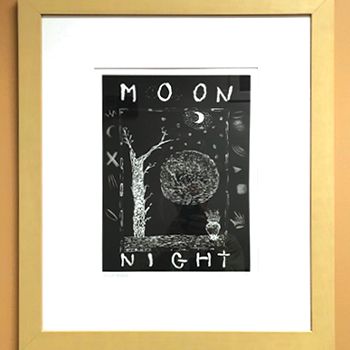
Moon Night
Research Park
Moon Night
Squeak Carnwath
Etching
1983
Squeak Carnwath draws upon the philosophical and mundane experiences of daily life in her paintings and prints, which can be identified by lush fields of color combined with text, patterns, and identifiable images. She has received numerous awards including the Society for the Encouragement of Contemporary Art (SECA) Award from San Francisco Museum of Modern Art, two Individual Artist Fellowships from the National Endowment for the Arts, a Guggenheim Fellowship, the Award for Individual Artists from the Flintridge Foundation, and the Lee Krasner Lifetime Achievement Award from the Pollock-Krasner Foundation. In 2019, she was inducted into the National Academy of Design and Art. Carnwath is Professor Emerita at the University of California, Berkeley. She lives and works in Oakland, CA.
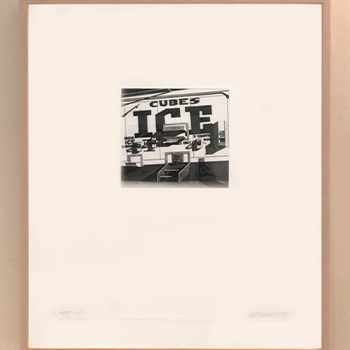
Ice
Research Park
Ice
Robert Cottingham
Etching
1975
Robert Cottingham is an American painter best known for his Photorealist depictions of cropped commercial signage. Born in Brooklyn, NY, Cottingham studied at Pratt Institute, where he received his BFA in 1963 before starting a five-year career in commercial advertising. Upon moving to Los Angeles Cottingham seriously committed himself to his own painting practice, which eventually subsumed his advertising career by 1968 as the artist rose to prominence along with the Photorealist movement. Cottingham is considered among the 13 most prominent Photorealists of the latter half of the 20th century—he disavowed his relationship to the movement. Instead, he views his own work as part of the lineage of vernacular Americana painters, including the likes of Stuart Davis and Edward Hopper. .

Untitled
Research Park
Untitled
Laddie John Dill
Monotype
1982
A central figure in the California Light and Spacemovement, Laddie John Dill has been crafting light and earthy materials like concrete, glass, sand, and metal into luminous sculptures, wall pieces, and installations since the 1970s. Referring to his choice of materials, Dill explains: “I was influenced by [Robert] Rauschenberg, Keith Sonnier,Robert Smithson, Dennis Oppenheim, and Robert Irwin, who were working with earth materials, light, and space as an alternative to easel painting.” Among his most celebrated works is an untitled installation from 1971, for which Dill filled a gallery with mounds of pale sand, topped with precisely arranged glass panels illuminated by the soft, green glow of argon lighting set just beneath the surface. When he does use canvas, he paints with pigments derived from cement and natural oxides.
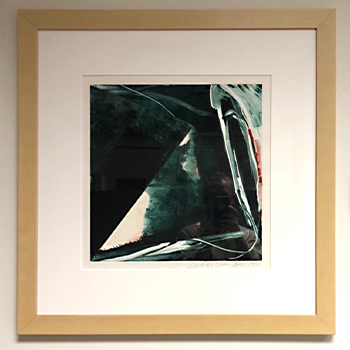
Untitled
Research Park
Laddie John Dill
Etching
1982
A central figure in the California Light and Spacemovement, Laddie John Dill has been crafting light and earthy materials like concrete, glass, sand, and metal into luminous sculptures, wall pieces, and installations since the 1970s. Referring to his choice of materials, Dill explains: “I was influenced by [Robert] Rauschenberg, Keith Sonnier,Robert Smithson, Dennis Oppenheim, and Robert Irwin, who were working with earth materials, light, and space as an alternative to easel painting.” Among his most celebrated works is an untitled installation from 1971, for which Dill filled a gallery with mounds of pale sand, topped with precisely arranged glass panels illuminated by the soft, green glow of argon lighting set just beneath the surface. When he does use canvas, he paints with pigments derived from cement and natural oxides.
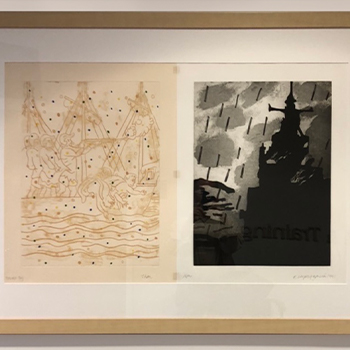
Now and Then
Research Park
Now and Then
Rupert Garciá
Etching
1991
Deeply entrenched in the activist communities of the San Francisco Bay Area, renowned poster-maker Rupert Garcia creates artwork that synthesizes his political background with a graphic, pop sensibility. Garcia came of age in the post-’68 era, creating screenprints, drawings, and pastel paintings of subject matter drawn from documentary photographs and paintings, and inflected with his political affiliations. Garcia rendered figures like Frida Kahlo or unnamed political prisoners with the bold colors and sharp lines of Warhol or Lichtenstein. Applying the apolitical style of pop to political icons, Garcia melds the sometimes-dissonant aesthetic and social currents of his time. Among his influences are the Mexican muralists Diego Rivera, Jose Clemente Orozco, and David Siqueiros.
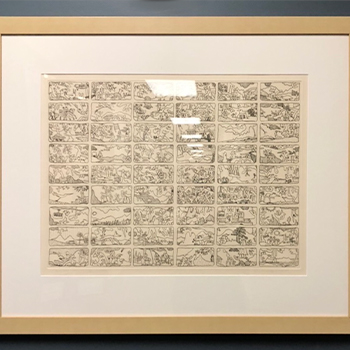
Early Riser
Research Park
Early Riser
John Himmelfarb
Etching
1977
John Himmelfarb is an American painter, draftsman, and printmaker. Born in Chicago, Illinois, he grew up in a household of artists (his parents being artists) surrounded by their art and the countryside that inspired them. John finished his undergraduate studies at Harvard University in liberal arts with a major in architectural sciences. He opened a studio in Chicago in 1970 and has worked primarily in Chicago since that time.
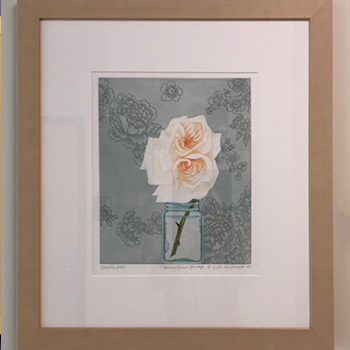
Double Rose
Research Park
Double Rose
Beth Van Hoesen
Etching
1982
Beth Van Hoesen was born in Boise, Idaho. She moved with her family to California, and in 1944, enrolled at Stanford University to study fine arts, earning a Bachelor of Arts degree in 1948. Van Hoesen’s work uses realism and tonality to create bold images of animals and botanicals, she accomplishes this by building up color through the process of etching. Van Hoesen distinguished herself as a draftsman and printmaker throughout her career. She was honored with numerous awards and solo exhibitions at museums and recognized by a multitude of institutions.
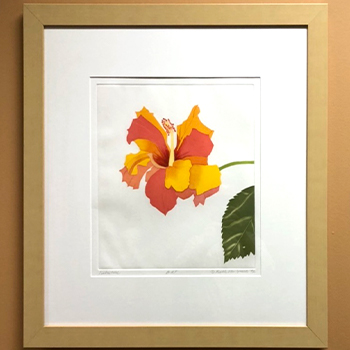
Hibiscus
Research Park
Hibiscus
Beth Van Hoesen
Etching
1982
Beth Van Hoesen was born in Boise, Idaho. She moved with her family to California, and in 1944, enrolled at Stanford University to study fine arts, earning a Bachelor of Arts degree in 1948. Van Hoesen’s work uses realism and tonality to create bold images of animals and botanicals, she accomplishes this by building up color through the process of etching. Van Hoesen distinguished herself as a draftsman and printmaker throughout her career. She was honored with numerous awards and solo exhibitions at museums and recognized by a multitude of institutions.
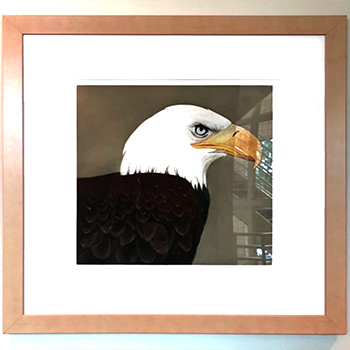
Ichi
Research Park
Ichi
Beth Van Hoesen
Etching
1982
Beth Van Hoesen was born in Boise, Idaho. She moved with her family to California, and in 1944, enrolled at Stanford University to study fine arts, earning a Bachelor of Arts degree in 1948. Van Hoesen’s work uses realism and tonality to create bold images of animals and botanicals, she accomplishes this by building up color through the process of etching. Van Hoesen distinguished herself as a draftsman and printmaker throughout her career. She was honored with numerous awards and solo exhibitions at museums and recognized by a multitude of institutions.
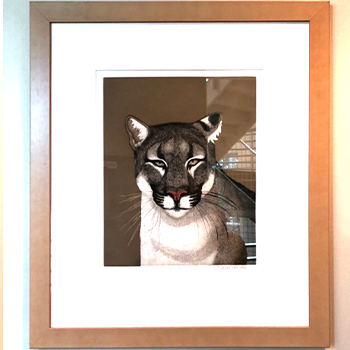
Maharani
Research Park
Maharani
Beth Van Hoesen
Etching
1989
Beth Van Hoesen was born in Boise, Idaho. She moved with her family to California, and in 1944, enrolled at Stanford University to study fine arts, earning a Bachelor of Arts degree in 1948. Van Hoesen’s work uses realism and tonality to create bold images of animals and botanicals, she accomplishes this by building up color through the process of etching. Van Hoesen distinguished herself as a draftsman and printmaker throughout her career. She was honored with numerous awards and solo exhibitions at museums and recognized by a multitude of institutions.
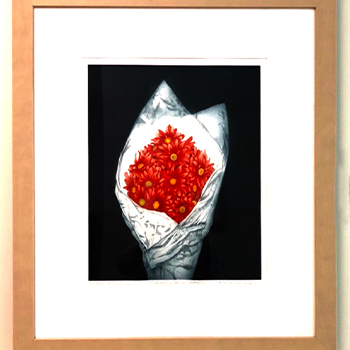
Wrapped Flowers
Research Park
Wrapped Flowers
Beth Van Hoesen
Etching
1985
Beth Van Hoesen was born in Boise, Idaho. She moved with her family to California, and in 1944, enrolled at Stanford University to study fine arts, earning a Bachelor of Arts degree in 1948. Van Hoesen’s work uses realism and tonality to create bold images of animals and botanicals, she accomplishes this by building up color through the process of etching. Van Hoesen distinguished herself as a draftsman and printmaker throughout her career. She was honored with numerous awards and solo exhibitions at museums and recognized by a multitude of institutions.
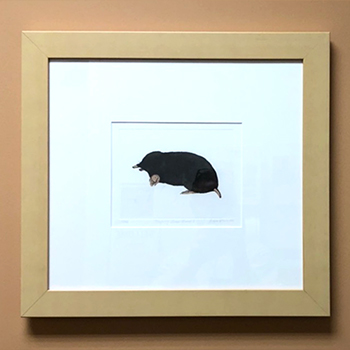
Mole
Research Park
Mole
Beth Van Hoesen
Etching
1982
Beth Van Hoesen was born in Boise, Idaho. She moved with her family to California, and in 1944, enrolled at Stanford University to study fine arts, earning a Bachelor of Arts degree in 1948. Van Hoesen’s work uses realism and tonality to create bold images of animals and botanicals, she accomplishes this by building up color through the process of etching. Van Hoesen distinguished herself as a draftsman and printmaker throughout her career. She was honored with numerous awards and solo exhibitions at museums and recognized by a multitude of institutions.
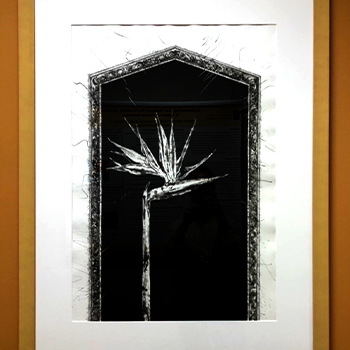
Black Bird
Research Park
Black Bird
Victoria Nodiff
Etching
1981
Victoria Nodiff-Netanel has been a horsewoman all her life. From pretending to be a horse as a kid in Wisconsin to painting photorealistic horses at California Institute of the Arts, from toy horses to competing in dressage at the Intermediaire level, Victoria has always known the magic of horses. In 2007, after many years of competing in dressage, Victoria shifted gears when a little horse came into her life. She realized that she wanted to help people with this miniature horse and she immediately started training Pippin, putting all her years of horsemanship to work.
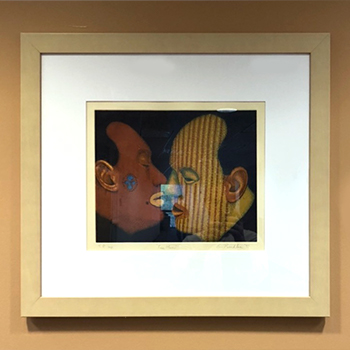
Free Man
Research Park
Free Man
Ed Paschke
Etching
1996
Highly influenced by the photo-based portraiture of Andy Warhol, Ed Paschke created portraits modeled from images sourced from popular media and American subcultures. By the aid of an opaque project. He was one of the first artists to paint using this technology—Paschke combined separate features culled from newspapers, tabloids, television, and pornographic magazines into single compositions. His early work was known for parodying celebrities and portraying marginal members of society; he later transitioned from recognizable subjects to anonymous, masked characters who appeared to be distorted by a malfunctioning television.
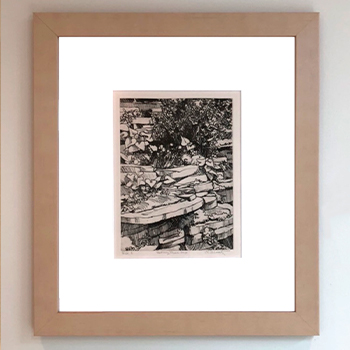
R.G. #1
Research Park
R.G. #1
Carl Schwartz
Etching
1978
Carl Schwartz, born in Detroit, Michigan, is a painter and print-maker, who currently resides in Fort Myers, Florida. He is a realist, whose work shows the influence of both abstract expressionism and cubism. For almost thirty years, Schwartz taught figure drawing and painting in Chicago at the North Shore Art League, until moving to Florida in 1984. There he resumed teaching at Edison Community College and at Florida Gulf Coast University. At the home he shares with his wife Dinah Schwartz, he raises Koi, a type of Oriental goldfish, which, along with water lilies, are often subjects in his art.
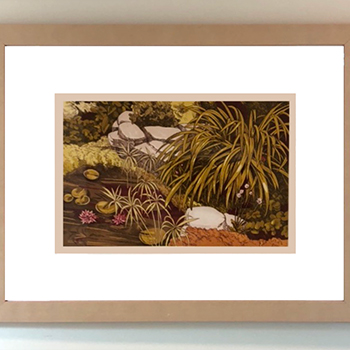
Water Palms
Research Park
Water Palms
Carl Schwartz
Etching
1976
Carl Schwartz, born in Detroit, Michigan, is a painter and print-maker, who currently resides in Fort Myers, Florida. He is a realist, whose work shows the influence of both abstract expressionism and cubism. For almost thirty years, Schwartz taught figure drawing and painting in Chicago at the North Shore Art League, until moving to Florida in 1984. There he resumed teaching at Edison Community College and at Florida Gulf Coast University. At the home he shares with his wife Dinah Schwartz, he raises Koi, a type of Oriental goldfish, which, along with water lilies, are often subjects in his art.
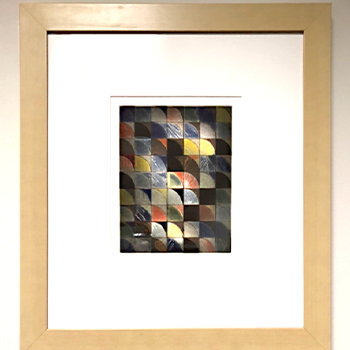
Winterhill
Research Park
Winterhill
Ann Thornycroft
Etching
1983
Ann Thornycroft was born and raised in the English countryside, drawing on her experiences and memories of nature as the basis for her abstract compositions. Thornycroft is best known for her large-scale, gridded compositions, though the execution of these works varies in rigidity and expressiveness. In explaining her use of this structure, the artist wrote, “The grid symbolized nature and man. It is a very simple device but it continues to capture my interest.” Recurring motifs in Thornycroft’s work also include overlapping circular forms and arcs that resemble botanical forms.
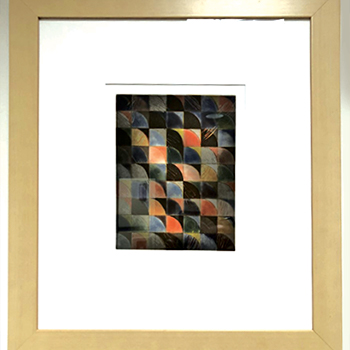
Woodnish
Research Park
Woodnish
Ann Thornycroft
Etching
1983
Ann Thornycroft was born and raised in the English countryside, drawing on her experiences and memories of nature as the basis for her abstract compositions. Thornycroft is best known for her large-scale, gridded compositions, though the execution of these works varies in rigidity and expressiveness. In explaining her use of this structure, the artist wrote, “The grid symbolized nature and man. It is a very simple device but it continues to capture my interest.” Recurring motifs in Thornycroft’s work also include overlapping circular forms and arcs that resemble botanical forms.
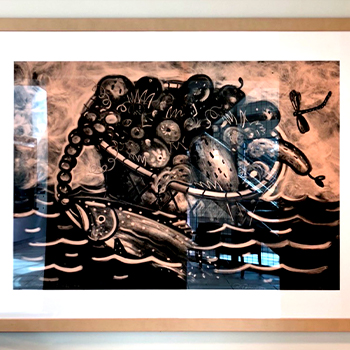
Rise Form
Research Park
Rise Form
Richard Thompson
Monotype
1992
Since Richard Thompson began painting in the 1960’s, he has used a visual vocabulary of landscape and still life images. Now, fifty years later, those images continue to mature. The paintings grow from all that he sees and all that he thinks about in the world around him. Over the last decade Richard has explored the rural, agricultural landscape of the American west with its distant horizons, far away mountains, geometric field patterns and farm buildings seen as if they are still life elements on a wide, vast table.
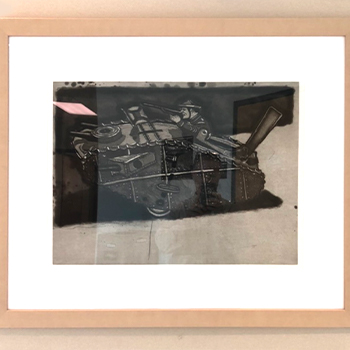
Toy Tank II
Research Park
Toy Tank II
Robert Weaver
Etching
1974
With a highly expressionistic and very personal vision, Weaver has become one of the Midwest’s most celebrated artists. Weaver was born in Stilwell Kansas, and received his BA from the Kansas City Art Institute and his BFA from the University of New Mexico in 1965. He went on to receive his MFA from the University of Nebraska-Lincoln in 1968. Weaver has worked in a variety of mediums and techniques: ink, charcoal, lithograph, oil paint, woodcut, pencil and pastel. Though he briefly experimented with abstraction in the 1950s and 1960s, Weaver is best known for his realistic and intimate portraiture and subjects taken from nature. These works are deeply connected to his own history and his experiences growing up in rural Kansas.
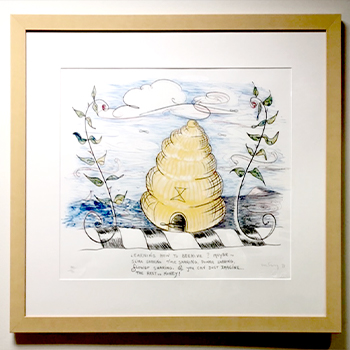
Beehive
Research Park
Beehive
William T. Wiley
Lithograph
1998
William T. Wiley is a contemporary American artist. Maintaining an eclectic practice that has been associated with the Funk Art movement, Wiley incorporates drawing, painting, sculpture, performance, and filmmaking into his work. His paintings act as an aggregate and are composed of a wide range of obsessive marks, materials, and mediums, frequently layered on top of a map or other information-coded images. Often featuring illustrations of fantastical universes, his works contain both historical literary references and integrate geometric abstraction. Born in Bedford, IN on October 21, 1937, he earned both his BFA and MFA from the California School of Fine Arts shortly before joining the UC Davis Art faculty in 1963, where he would instruct and influence prominent artists like Bruce Nauman. Wiley has enjoyed widespread acclaim and success, participating in both the Venice and Whitney Biennials in 1980 and 1983, respectively. His work is held in many important collections, such as the Art Institute of Chicago, The Museum of Modern Art in New York, and the Smithsonian American Art Museum in Washington, D.C. The 2009–2010 exhibition “What’s It All Mean: William T. Wiley in Retrospect,” offered a comprehensive retrospective of Wiley’s career.
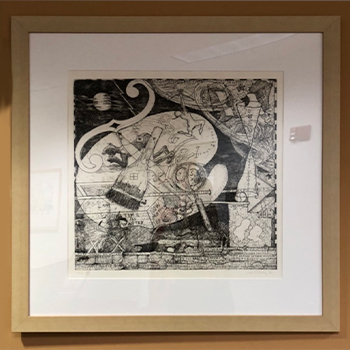
Planks Pool
Research Park
Planks Pool
William T. Wiley
Etching
1980
William T. Wiley is a contemporary American artist. Maintaining an eclectic practice that has been associated with the Funk Art movement, Wiley incorporates drawing, painting, sculpture, performance, and filmmaking into his work. His paintings act as an aggregate and are composed of a wide range of obsessive marks, materials, and mediums, frequently layered on top of a map or other information-coded images. Often featuring illustrations of fantastical universes, his works contain both historical literary references and integrate geometric abstraction. Born in Bedford, IN on October 21, 1937, he earned both his BFA and MFA from the California School of Fine Arts shortly before joining the UC Davis Art faculty in 1963, where he would instruct and influence prominent artists like Bruce Nauman. Wiley has enjoyed widespread acclaim and success, participating in both the Venice and Whitney Biennials in 1980 and 1983, respectively. His work is held in many important collections, such as the Art Institute of Chicago, The Museum of Modern Art in New York, and the Smithsonian American Art Museum in Washington, D.C. The 2009–2010 exhibition “What’s It All Mean: William T. Wiley in Retrospect,” offered a comprehensive retrospective of Wiley’s career.
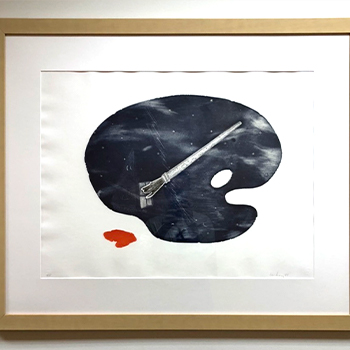
O.T.P.A.G for P.G.
Research Park
O.T.P.A.G for P.G.
William T. Wiley
Etching
1981
William T. Wiley is a contemporary American artist. Maintaining an eclectic practice that has been associated with the Funk Art movement, Wiley incorporates drawing, painting, sculpture, performance, and filmmaking into his work. His paintings act as an aggregate and are composed of a wide range of obsessive marks, materials, and mediums, frequently layered on top of a map or other information-coded images. Often featuring illustrations of fantastical universes, his works contain both historical literary references and integrate geometric abstraction. Born in Bedford, IN on October 21, 1937, he earned both his BFA and MFA from the California School of Fine Arts shortly before joining the UC Davis Art faculty in 1963, where he would instruct and influence prominent artists like Bruce Nauman. Wiley has enjoyed widespread acclaim and success, participating in both the Venice and Whitney Biennials in 1980 and 1983, respectively. His work is held in many important collections, such as the Art Institute of Chicago, The Museum of Modern Art in New York, and the Smithsonian American Art Museum in Washington, D.C. The 2009–2010 exhibition “What’s It All Mean: William T. Wiley in Retrospect,” offered a comprehensive retrospective of Wiley’s career.
